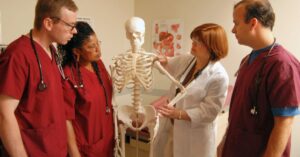Digital innovation now threads through every corridor of healthcare, and nowhere is its impact more visible than at the nurse’s station. From smart pumps that avert medication errors to artificial-intelligence dashboards that flag sepsis hours earlier, technology is transforming how nurses plan, deliver, and evaluate patient care. The Role of Technology in Nursing is no longer a niche concept; it is the backbone of modern practice, enabling professionals to balance compassion with precision.
At the same time, new tools bring new questions. How do electronic health records affect bedside rapport? Can robotics lighten workloads without eroding the “human touch”? What safeguards protect sensitive data when care travels over Wi-Fi to remote villages? This guide answers those questions and more, offering a clear, NLP-friendly overview for students, practising nurses, health-tech investors, and policy makers alike.
By the end you will understand how the Role of Technology in Nursing spans clinical documentation, decision support, remote monitoring, education, ethics, and global outreach and why embracing it thoughtfully is vital for safer, smarter, and more equitable care.
In This Article
1. From Bedside to Bytes: The Evolution of Nursing Technology
The Role of Technology in Nursing has deep roots. In the 1850s Florence Nightingale famously used statistical charts to show that hygiene lowered mortality, marrying data with practice. Fast-forward to the 1980s and nurses adopted barcode medication administration to cut drug errors.
The 2000s unleashed electronic health records (EHRs), smart infusion pumps, and early telehealth pilots. Today cloud-based platforms, predictive analytics, and virtual reality shape daily routines, reflecting a steady shift from paper to pixels. Understanding this timeline matters because each wave builds competencies required for the next.
2. Electronic Health Records: Accuracy, Access, and Analytics
EHRs sit at the epicentre of the Role of Technology in Nursing. Digital charts replace illegible handwriting, offering real-time access to allergies, lab trends, and care plans. Nurses save time with templated assessments and automated vital-sign uploads. Clinical decision support alerts reduce duplicate tests and highlight drug interactions.
Data pooled across populations also fuels quality-improvement dashboards, letting nurse managers spot infection clusters before they escalate. However, screen glare can distract from patient eye contact, so ergonomics and workflow redesign remain essential.
3. Clinical Decision Support Systems: Safer, Smarter Care
CDSS tools range from simple dose calculators to AI engines predicting sudden deterioration. For nurses, colour-coded alerts embedded in the EHR help catch sepsis early or remind staff of central-line dressing schedules. The Role of Technology in Nursing here is twofold: augment judgement without replacing it, and translate raw numbers into actionable insights.
Studies show CDSS use cuts adverse drug events by up to 40 %, yet alarm fatigue looms if thresholds are poorly tuned. Continuous feedback from bedside nurses is therefore critical.
4. Telehealth and Remote Nursing Practice
During the pandemic tele-nursing leapt from pilot to mainstream, illustrating the flexible Role of Technology in Nursing. High-definition video calls allow triage nurses to assess wounds, guide inhaler technique, or coach new mothers on breastfeeding. Remote monitoring kits stream blood pressure, glucose, and oxygen data to virtual wards staffed by registered nurses.
Benefits include reduced travel, shorter hospital stays, and quicker specialist access for rural patients. Challenges centre on broadband equity, licensure across borders, and maintaining rapport through screens.
5. Mobile Health Apps and Wearable Devices in Patient Monitoring
Smartwatches that track atrial fibrillation, patches that measure temperature, and phone apps reminding stroke survivors to take anticoagulants all expand the Role of Technology in Nursing beyond clinic walls. Nurses review dashboards flagging deviations and offer timely interventions that prevent admissions.
Wearables also empower self-management when nurses teach clients to interpret feedback. Yet data overload is real; setting clear escalation criteria keeps workloads manageable and ensures only clinically relevant alerts surface.
6. Artificial Intelligence and Predictive Analytics
AI unlocks patterns hidden in vast datasets—predicting pressure-ulcer risk, optimising staffing, or forecasting emergency-department surges. The Role of Technology in Nursing here involves both collaboration and oversight. Nurses validate algorithm outputs against real-life context and escalate when models miss nuances.
Predictive staffing tools can reduce overtime burnout, while AI-assisted triage in call centres accelerates ambulance dispatch for stroke symptoms. Ethical use demands transparency: nurses must know why an AI recommends action to explain it to patients confidently.
7. Robotics and Automation in Routine Nursing Tasks
From autonomous UV disinfection robots to robotic lifts that safely transfer immobile patients, automation is reshaping manual duties. The Role of Technology in Nursing with robotics focuses on safety and efficiency. Robots deliver linens, blood products, and meals, freeing nurses to spend more time teaching or comforting families.
Pilot wards report a 15 % reduction in musculoskeletal injuries thanks to mechanical hoists. Still, nurses remain responsible for oversight, ensuring sensors act correctly and patients feel supported, not replaced
8. Smart IV Pumps and Medication Safety
Infusion errors rank among top adverse events. Smart pumps with dose-error reduction software add a safety net, making medication technology central to the Role of Technology in Nursing. Drug libraries store weight-based limits; alarms trigger if a nurse inputs an unsafe rate.
When integrated with the EHR, pumps auto-populate infusion parameters, slashing transcription steps. Ongoing maintenance of drug libraries and rigorous double-checks preserve reliability.
9. Virtual Reality and Simulation in Nursing Education
Clinical placements can be scarce, but VR headsets now drop students into realistic code-blue scenarios without risk. Haptic gloves simulate pulse checks, letting learners hone psychomotor skills.
The Role of Technology in Nursing education emphasises experiential learning: studies show VR boosts knowledge retention by 20 % compared with lectures alone. Advanced mannequins add voice, bleeding, and pupil reaction, further bridging theory and practice before novices meet real patients.
10. Blockchain and Data Security for Patient Privacy
Cyber-attacks on hospitals underscore the defensive Role of Technology in Nursing. Blockchain’s decentralised ledger can record medication chains-of-custody or consent forms, making tampering near impossible.
Nurses as custodians of patient trust must grasp basic cybersecurity hygiene—strong passwords, phishing awareness—and champion secure messaging apps over consumer chat tools. Working knowledge of encryption builds confidence when educating patients about digital privacy rights.
11. Interoperability and Health Information Exchange
Seamless data flow between GP clinics, community pharmacies, and acute wards prevents duplication and gaps. Fast Healthcare Interoperability Resources (FHIR) standards power apps letting nurses reconcile discharge meds instantly.
The Role of Technology in Nursing thus involves advocating for systems that “speak” to each other, reducing manual faxing and phone chases. Interoperability also supports population health as aggregated nursing data guide policy on vaccination or chronic-disease management.
12. Nurse-Led Innovation: Design Thinking at the Bedside
Front-line insight positions nurses as natural inventors. Hackathons now pair staff nurses with software developers to streamline wound-care photo uploads or design documentation shortcuts. By stepping into product-owner roles, nurses ensure technology addresses genuine pain points.
The Role of Technology in Nursing innovation space therefore transcends adoption—it shapes creation, pushing user-centred design that values ergonomics and empathy.
13. Ethical and Legal Considerations of Digital Nursing
Autonomy, beneficence, and justice guide nursing ethics; technology introduces new wrinkles. Who is liable if an AI triage bot misclassifies chest pain? How do we prevent bias in predictive models trained on unrepresentative data?
The Role of Technology in Nursing demands digital literacy to question algorithms and defend patient rights. Updated nursing codes now include data stewardship clauses, urging lifelong learning on emerging tech and relevant legislation such as GDPR and HIPAA.
14. Technology and Nursing Workload: Burnout or Brilliance?
Critics worry that constant alerts and screen time strain nurses. Research shows mixed outcomes; EHRs may initially extend charting hours yet later shorten them once proficiency grows. Automated vitals and voice-to-text tools cut paperwork, while self-scheduling apps reduce roster conflicts.
The Role of Technology in Nursing workforce well-being hinges on thoughtful deployment—training, user support, and involvement in system selection markedly improve satisfaction scores.
15. Rural and Global Health Impacts of Tele-Nursing
A single smartphone can bridge miles of desert or jungle, making tele-nursing a lifeline. Projects in India, Kenya, and Australia equip community nurses with solar-powered tablets and satellite links to specialists. Maternal mortality drops when midwives can video-consult obstetricians.
Thus, the Role of Technology in Nursing extends social justice, delivering expertise where roads may not. However, cultural competence and reliable infrastructure remain prerequisites for success.
16. The Future of Technology-Enhanced Holistic Nursing
Looking ahead, digital twins—virtual replicas of patients updating in real time—could let nurses test treatment plans risk-free. Quantum-level encryption may safeguard gen-omics data stored in cloud vaults.
Meanwhile, empathy-training chatbots could rehearse difficult conversations. The Role of Technology in Nursing will revolve around synergy: blending high-tech precision with high-touch compassion to keep human dignity at the centre of care.
Table 1. Key Technologies and their Nursing Benefits
| Technology | Primary Nursing Benefit | Sample Metric Improved |
|---|---|---|
| Electronic Health Records | Faster, clearer documentation | Notes completion time ↓ 30 % |
| Clinical Decision Support | Early warning for deterioration | Code blues per 1 000 patients ↓ 25 % |
| Telehealth Platforms | Expanded access for remote patients | No-show rate ↓ 18 % |
| Smart Infusion Pumps | Reduced medication errors | IV error rate ↓ 40 % |
| Wearable Remote Monitoring | Early intervention on vital changes | Readmissions ↓ 12 % |
| Virtual-Reality Simulation | Enhanced skills retention in trainees | Exam pass rate ↑ 20 % |
Must Read:
- The Impact of Nurse-to-Patient Ratios on Patient Outcomes
- Holistic Nursing Approaches 2025 Guide to Mind-Body Care
- Nurse-Led Care Models: Effectiveness Across Healthcare Settings
FAQs:
1. Will technology replace nurses?
No. Tools automate routine tasks, but empathy, critical thinking, and advocacy remain human strengths that technology cannot replicate.
2. How can nurses keep pace with rapid tech changes?
Seek continuous professional development courses, join interdisciplinary committees, and participate in pilot projects to gain hands-on experience.
3. Does tele-nursing compromise patient privacy?
When platforms use end-to-end encryption and role-based access controls, privacy can be equal or superior to in-person care. Nurses must still follow local regulations.
4. Are AI predictions legally binding?
AI offers recommendations, not mandates. Final clinical judgement—and responsibility—rests with licensed professionals.
5. What funding supports nursing technology in low-resource settings?
Many NGOs and global-health grants now prioritise digital tools; partnerships with telecom companies also supply discounted data packages and devices.
6. How does technology affect nurse–patient rapport?
When used mindfully—positioning screens to maintain eye contact, explaining devices—technology can enhance trust by demonstrating thoroughness and transparency.
Conclusion:
Technology has journeyed from optional extra to essential ally, redefining the nurse’s toolkit. Electronic records cut duplication, decision support averts crises, and tele-platforms carry expertise across mountains and seas. As we have explored, the Role of Technology in Nursing is complex and multifaceted: it streamlines workflows, widens access, and powers data-driven insight, yet requires vigilance against burnout, bias, and breaches.
Ultimately, successful integration depends less on silicon and code than on the professionals who wield them. Nurses who approach innovation with curiosity, ethical reflection, and patient-centred focus will unlock tech’s full promise—delivering care that is safer, smarter, and profoundly human. Hospitals that invest in robust training, inclusive design, and emotional-intelligent leadership will see digital tools lift morale rather than pile on clicks.
As 2025 unfolds, the frontier continues to expand virtual-reality home visits, AI-guided staffing, genetic-based precision nursing all poised to elevate outcomes. By embracing a collaborative mindset, the nursing profession can shape this evolution, ensuring every gadget and algorithm amplifies, not replaces, the healing art at the heart of nursing.







